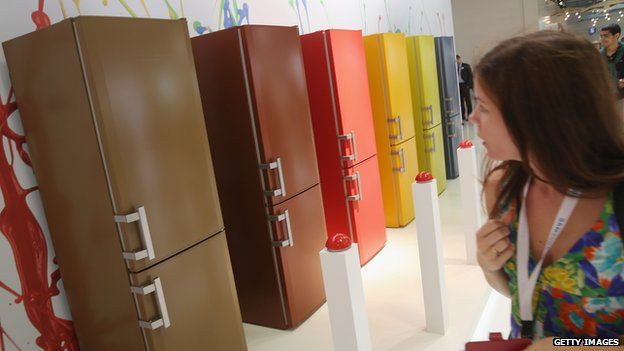Fridgeonomics and a 'zero waste' world
- Published
- comments

After a five-year effort, Unilever tells me that it has achieved zero waste in all of its 240 factories in 67 countries worldwide. It says that it generates efficiency savings of €200m a year by eliminating disposal costs. Smaller businesses like restaurants have aimed for zero wastage, but Unilever - which makes PG Tips and Ben & Jerry's ice cream - says it's the first global company to do so.
It's a fairly remarkable claim and achievement since undoubtedly landfill waste has a huge environmental cost. The UK government estimates that households in England alone generate 177 million tonnes of waste each year.
So, if it's good for business and the environment, then why hadn't Unilever and other businesses done this before?
I put that question to Pier Luigi Sigismondi who heads Unilever's supply chain. He said that the ethos around sustainability has shifted sufficiently to get one of the world's biggest companies to launch this initiative. Remember that Unilever has had problems with environmental groups; for instance, as the biggest buyer of palm oil. Environmental groups have been concerned with the rate of deforestation in places such as Indonesia due to palm oil extraction. So, the stakeholder pressures appear to be there.
When I asked if up-front capital costs are what puts businesses off, because most are geared for shorter-term returns, Mr Sigismondi pointed out that this was also changing as the biggest companies increasingly recognise the need to address sustainability.
It's an issue that came up when we discussed Fridgeonomics on Talking Business this week.
As part of A Richer World season, we peered into people's fridges to see how consumption patterns are changing with incomes. Refrigerators also contribute to global warming and the rate of refrigeration use is growing rapidly in the emerging world. So, we discussed technologies that use solar power, and other innovations that try to reduce the environmental impact and also allow more of the developing world to have refrigerators even in places with patchy electricity.
Indeed, even with electrification challenges, owning a fridge is a mark of becoming middle class. The top three wish list items for a household emerging from poverty are a TV, a mobile phone and a fridge.
Why is Fridgeonomics useful?
When China reached middle income status a decade ago, about a quarter of the population had fridges. Now, it's about 90%, just shy of the 99% rate found in developed countries. In India, which still hasn't reached $3,000 per capita income, fridge ownership is about 27% and growing as the middle class expands.
Of course, rising incomes generate a growing demand for food, and a richer variety including meat. Global food production will need to increase by at least 60% to meet this demand by 2050 when the global population is expected to grow by two billion to nine billion. That poses sustainability challenges too.
Peering inside fridges around the world, it turns out that basic items, such as milk, comprised about 10 items. According to research by AllianceBernstein, for middle class households, there were more indulgent items such as ice cream. For the affluent, their fridges were stocked with healthier foods such as low-fat yogurt.
So, as more of the world becomes richer, the challenges around sustainability will also increase.
If, as it claims, Unilever has managed to make a business work with zero non-hazardous wastage, then that would a big step forward on an issue that will only gain in importance as the world gets richer.